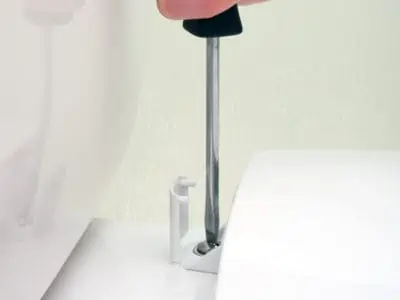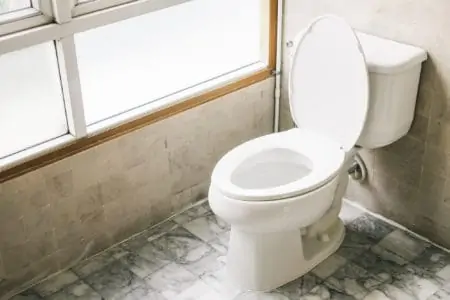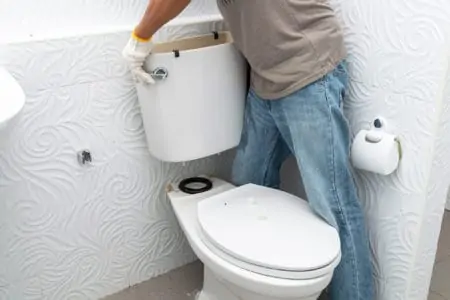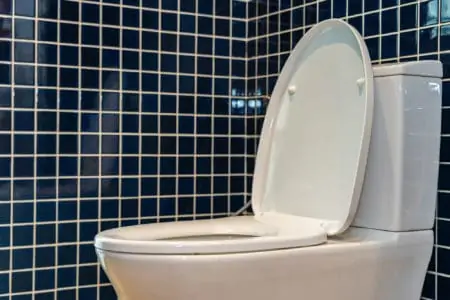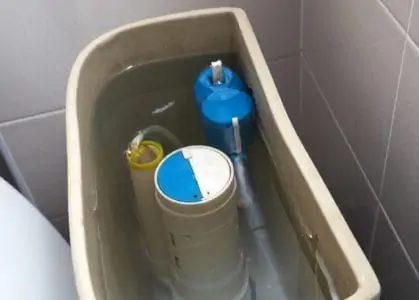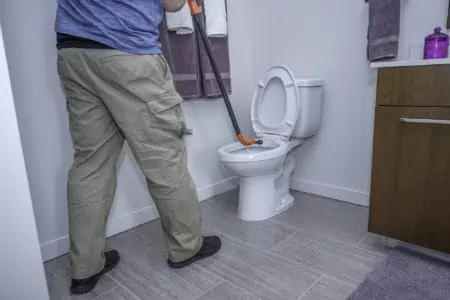Do you have a stubborn toilet seat that refuses to stay in place? This is annoying, but an unstable seat can cause you to fall off the toilet, which is dangerous in several ways.
Learn how to tighten the toilet seat and what to do if the bolts keep coming loose or if you have no access to the underside.
Key Takeaways
- Identify the type of toilet seat fixings: Different toilet seats have various fixing mechanisms, like bottom or top fixings, and can have plastic or metal bolts.
- How to tighten plastic bolts: Locate the bolts (usually under plastic tabs), use a flathead screwdriver to tighten them, and consider adding washers for extra stability.
- How to tighten metal bolts: Locate the metal bolts (possibly under plastic covers), use a flathead screwdriver and adjustable wrench to tighten them, and avoid over-tightening to prevent breakage.
- Addressing persistent looseness: If the seat keeps coming loose, try using a toilet tightening kit, installing seat stabilizers, or replacing the toilet seat altogether.
Types of Toilet Seat Fixings
Before learning how to fix a loose toilet seat, it’s important to be able to tell the different toilet seat fixings apart from one another. Toilet seats are held in place with screws or bolts that can be made from plastic or metal.
Toilet seat fittings that match the American standard are classified into bottom and top fixings.
The latter category works using two bolts that go into the pan and require tightening from the top. On the other hand, bottom fixings are fitted from the top, but you need to use wing nuts to tighten them from underneath.
If you’re unsure what fixings your seat uses, reach behind the toilet and check if there is a bolt. If you find a bolt, you have a seat with bottom fixing.
How to Tighten a Toilet Seat With Plastic Bolts
If you want to know how to fix a wobbly toilet, you should determine whether the seat’s bolts are made from plastic or metal. If your seat is made with plastic bolts, follow these steps to tighten them.
What You’ll Need
- Flathead screwdriver.
1. Locate the Bolts
Plastic bolts are usually tightened from the top and are usually covered by small plastic tabs. For those with concealed fixings, you have to lift them to reveal the bolts you want to tighten.
2. Tighten the Bolts
Place the screwdriver in the designated channel on the top side of the bolt. With your other hand, reach underneath to find the nut. Hold the screwdriver with the bolt on the top side without turning and turn the piece underneath instead.
Side Note
Experts suggest replacing plastic bolts with compatible metal ones since plastic strips out and don’t hold too much weight.
3. Add Washers
This step is optional, but washers are great for keeping the toilet seat in place. To install them, unscrew the bolts, put the washers in place (where the bolt meets the commode), put the bolts back, and tighten them in place.
How to Tighten a Toilet Seat with Metal Hinges
The following tutorial will teach you how to tighten a toilet seat with metal hinges.
What You’ll Need
- Flathead screwdriver.
- Adjustable wrench.
1. Locate the Bolts
Plastic covers might conceal the two metal bolts that hold your toilet seat in place. Locate them and lift them open. You might need to pry them open using a screwdriver in certain situations.
2. Tighten the Bolts
Once the bolts have been exposed, you can use your screwdriver to tighten them. Turn them clockwise until you notice resistance. Don’t force them beyond this point, or they might break.
If you can’t tighten the bolts in this fashion, hold the nuts at the base of the bolt in place using your hands, pliers, or a wrench and turn the bolts once again.
How to Tighten a Quick-Release Toilet Seat
A quick-release toilet uses a hinge mechanism to allow for the fast removal of the seat. Tightening a quick-release toilet seat isn’t different from a normal one as the bolts are pretty much the same.
What You’ll Need
- Flathead screwdriver.
- Wrench.
1. Release the Seat
Open the toilet seat all the way. Locate the quick release buttons on the left and right. Press on them to release the seat.
2. Pop Off the Caps
Using a flathead screwdriver, gently pry off the metal caps. This will expose two screws, and you can simply tighten them with the screwdriver.
3. Attach the Toilet Seat
Now that you’ve tightened the fittings, you can pop the seat back into place. The beauty of a quick-release toilet seat is that you can just line the holes up and firmly press until it clicks.
How to Tighten a Toilet Seat with No Access to Underside
This rarely is the issue as most toilets allow access to the underside. But if you have a wall-mounted toilet that’s flush all around, the only access you have is from the top.
The best solution is to remove the toilet seat. Push the bolts down through the holes. Replace with a quick-release seat that has top-fitting hinges.
Toilet Seat Keeps Coming Loose
If simple tightening doesn’t solve the issue, consider trying one of the following.
Buy a Toilet Tightening Kit
There are some methods to prevent the toilet seat from falling loose on you so frequently. For example, you can invest in a toilet seat tightening kit.
These should be easy to find online or at your local hardware store. The kit includes a tightening tool which you can use to tighten the bolt for a good fit.
Install Seat Stabilizers
This is a great hack for those with a toilet seat that moves from side to side. Seat stabilizers are these small plastic components that come with a rubber band.
You secure them to the bottom side of the seat and use the rubber band to tighten them around the seat. The stabilizers need to touch the rim of the bowl. These stabilize the seat of the toilet and prevent it from sliding left and right.
Replace the Toilet Seat
Sometimes, your only solution is to replace the toilet seat altogether. While toilet bowls have an average lifespan of 15 years, a toilet seat will only last about five to seven years. They are prone to cracks and stains and can sometimes be beyond repair.
While tightening the bolts usually stabilizes the seat, some parts might be broken. Consider buying a new toilet seat when every other toilet seat stabilization method fails.
FAQs
In the End
Once you know how to tighten the toilet seat, you have to determine the type of fixings and bolts you’re dealing with. Remember that you sometimes may need to turn to other solutions, such as installing seat stabilizers or installing a new toilet seat altogether.
